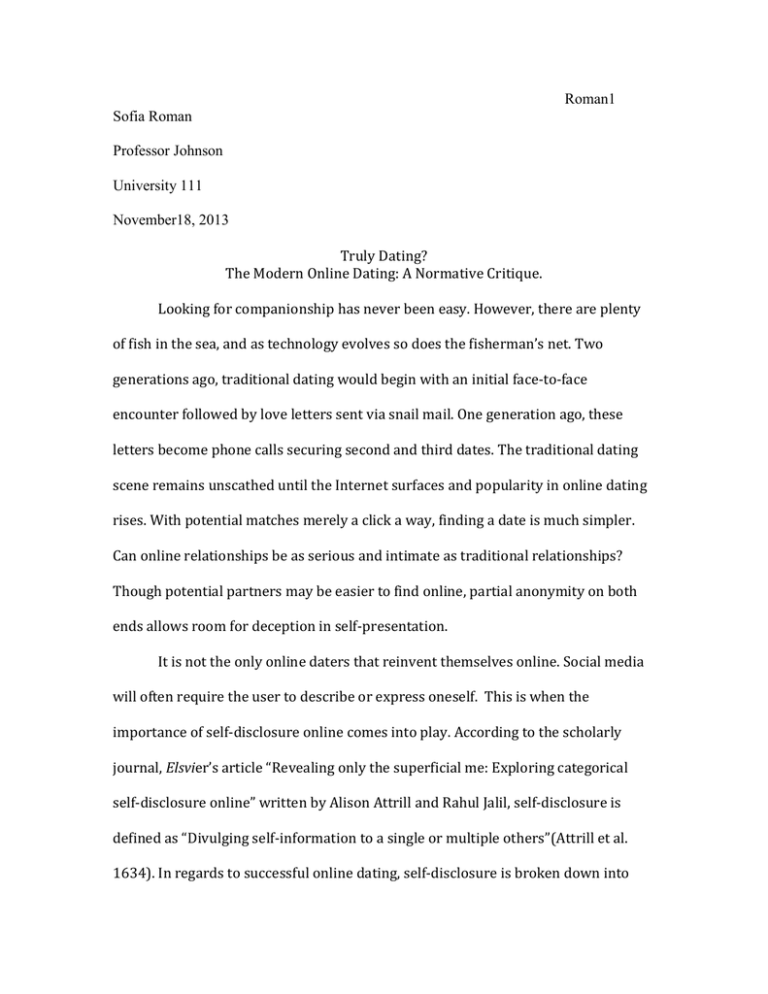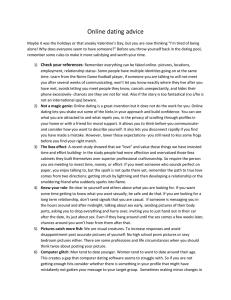Roman1 Sofia Roman Professor Johnson University 111
advertisement

Roman1 Sofia Roman Professor Johnson University 111 November18, 2013 Truly Dating? The Modern Online Dating: A Normative Critique. Looking for companionship has never been easy. However, there are plenty of fish in the sea, and as technology evolves so does the fisherman’s net. Two generations ago, traditional dating would begin with an initial face-to-face encounter followed by love letters sent via snail mail. One generation ago, these letters become phone calls securing second and third dates. The traditional dating scene remains unscathed until the Internet surfaces and popularity in online dating rises. With potential matches merely a click a way, finding a date is much simpler. Can online relationships be as serious and intimate as traditional relationships? Though potential partners may be easier to find online, partial anonymity on both ends allows room for deception in self-presentation. It is not the only online daters that reinvent themselves online. Social media will often require the user to describe or express oneself. This is when the importance of self-disclosure online comes into play. According to the scholarly journal, Elsvier’s article “Revealing only the superficial me: Exploring categorical self-disclosure online” written by Alison Attrill and Rahul Jalil, self-disclosure is defined as “Divulging self-information to a single or multiple others”(Attrill et al. 1634). In regards to successful online dating, self-disclosure is broken down into Roman 2 four sub categories; honesty, amount, intent, and valence (Attrill et al. 1636). Of the four sub categories, honesty is the most important because honest, positive selfdisclosure will result in a healthy and genuine online relationship. Online daters tend to share more personal information much faster than they would if speaking to a potential date in person. Eventually, the conversation will shift from superficial to more serious topics, which fall under the 5 subtypes of self-disclosure; beliefs, relationships, personal matter, interest, and intimate feelings (Attrill et al. 1637). As conversations evolve to become more serious, so does the foundation for the online relationship. Although self-disclosure is a factor that strengthens online relationships, high self-disclosure can have the opposite effect on a potential partner and repel them. This topic is explored in Elsvier’s article “Impact of emotionality and self disclosure on online dating versus traditional dating,” written by Larry D. Rosen, Nancy A. Cheever, Cheyenne Cummings, and Julie Felt when concluding that low levels of self disclosure shows strength and is generally preferred by online daters. Just as one can give too much information at once in a face to face encounter, it is important for the subject to maintain a moderate level of self disclosure by starting with small talk and asking deeper questions as the correspondence continues. According to Walther’s Hyperpersonal Perspective, Computer mediated communicators feel “anonymous, distant, and safe” (L.D. Rosen et al. 2128), which is why some may disclose too much information or exaggerate self-presentation. Within reason, exaggeration of personality and reciprocal self-disclosure can produce a healthy Roman 3 relationship, since “the reciprocal influences of this idealized perception and selective presentation created self-confirming prophecies, which leads to more intimacy,” (L.D. Rosen et al. 2129). First time face-to-face contact brings a sense of cautiousness of revealing too much. Cyberspace is a safe place for one to express their true self, so it comes to no surprise that many find it easier to meet new people online before they meet them for the first time in person. From the safety of cyberspace, online daters have the ability to strategize and plan social interactions while remaining faithful to their true self and develop actual self. Humanist Psychiatrist, Carl Rogers, defines true self as “one’s inner core- who they really are,” and one’s actual self as “traits that individuals possess and express to others in social settings”(Whitty 1709). According to M.T. Whitty’s article, “Revealing the ‘real’ me, searching for the ‘actual’ you: Presentations of self on an Internet dating site,” published in Computers in Human Behavior, “cyberspace is a safe place to identify ‘true’ self or play around with presentations,” and at the same time “how much people do this is restricted if they want to ensure their date is not disappointed when they meet face-to-face,” (Whitty 1716). One who is seriously interested in pursuing an offline relationship will not embellish to the point where it could cost them a potential date or make them seem deceitful. One compromises face-to-face (FTF) interaction when using computermediated communication (CMC) as a means for dating. Scholar D. Stanley Eitzen, a sociology professor at Colorado State University, expresses in his essay “The Atrophy of Social Life” that “social interaction is the basic building block of intimate Roman 4 relationships,” (158) and that technology is steering society away from forming intimate relationships. It is true that the Internet has lead to decrease in a sense of community in cities in suburbs; however, this sense of community still exists online. Through computer mediated communication. Eitzen believes that the lack of nonverbal cues in CMC is detrimental to the development of an intimate relationship because “technologies only create the illusion of communication and intimacy,” (159). While may be easier to communicate from behind a screen, technology can bring people together who otherwise would not have met. Since there is a decreased sense in community, more people turn to online dating as means to meet other and socialize with them in person. Mutual exchanges in self-disclosure through dating sites and social media makes online daters more comfortable and secure when meeting face to face. “Revealing only the superficial me: Exploring categorical self-disclosure online” and “Impact of emotionality and self disclosure on online dating versus traditional dating” agree that the participants in their studies tend to like each other more when they meet online compared to when they meet face-to-face. The lack of nonverbal cues lost in CMC are made up with message content, style, and timing. When both parties are serious about having an offline relationship, they want to express their real self-online. Whitty refers to the Altman and Taylor’s “Social Penetration Theory” to prove that online relationships flourish over time incrementally with the intimacy achieved through self-disclosure. The Social Penetration Theory argues that relationships get more and more intimate over time, Roman 5 and most importantly “how greater intimacy is achieved through depth and breadth of self disclosure,” (Whitty 1710). Ultimately, revealing one’s true self online will lead to a strong online relationship and transitions into a solid relationship when brought into real life. Online dating makes dating simpler as long as the pair will eventually engage in face-to-face communication after beginning their correspondence on the web. The limitations of the studies evaluated in “Revealing only the superficial me: Exploring categorical self-disclosure online” and “Impact of emotionality and self disclosure on online dating versus traditional dating” are the sample size of their subject and the fact that they did not test the various types of online dating, which may have different structure or target people with a certain interest of commonality. In addition, online dating may not be fruitful for every type of person. Online dating it geared more towards people who have difficulties finding time to socialize or just socializing in general. Regardless, the human desire to satisfy loneliness and find love and attention can be fulfilled even through online communication and selfdisclosure between individuals. Works Cited Larry D. Rosen, Nancy A. Cheever, Cheyenne Cummings, Julie Felt, The impact of emotionality and self-disclosure on online dating versus traditional dating, Computers in Human Behavior, Volume 24, Issue 5, September 2008, Pages 2124-2157, ISSN 0747-5632, http://dx.doi.org/10.1016/j.chb.2007.10.003. (http://www.sciencedirect.com/science/article/pii/S0747563207001574) Alison Attrill, Rahul Jalil, Revealing only the superficial me: Exploring categorical self-disclosure online, Computers in Human Behavior, Volume 27, Issue 5, September 2011, Pages 1634-1642, ISSN 0747-5632, http://dx.doi.org/10.1016/j.chb.2011.02.001. (http://www.sciencedirect.com/science/article/pii/S0747563211000343) Eitzen, D. Stanley. The Atrophy of Social Life. Evolving Ideas. Plymouth, MI: HaydenMcNeil Sustainability, 2013. 158-64. Print. Writer’s Memo I spent approximately 4 to 5 hours editing since turning in the first draft. Pegah’s peer review was the most helpful, as she suggested I clarify my definition for relationships and add more detail in my introduction to clearly show my purpose and claim. The model essays helped in figuring out an effective structure for text and transition between sources. An additional step I took to improve the essay was to get other colleagues to read it and give me feedback on the strength of my argument. I believe I have earned a B in this essay because I have a unique and valid thesis, good organization, I defined all unfamiliar terms, and I use my sources effectively. The global aspect I am most confident about is my evidence because my sources are reliable and have concrete findings in how online dating can be successful, which supports my claim. The global aspect I am least confident with is defining and addressing my audience because there is a diverse population of people who use online dating. Locally, I think my rebuttal is a strength in my paper because I was able to effectively refute it with logic, reasoning, and evidence from my sources that the claims made about computer mediated communication by the opposing source were not entirely true and more based on opinion. My weaker local aspect was in citing my sources and incorporating information about the sources in the text. This is because it was difficult for my ideas to flow while introducing the sources since my sentences would become too wordy. If I had more time to improve the essay, I would work on making the summaries of my articles more detailed. It would probably take an additional two hours since they evaluate several studies that differ slightly, however I did not want to lose focus on my claim so I addressed only the most significant findings and facts presented in the articles.







